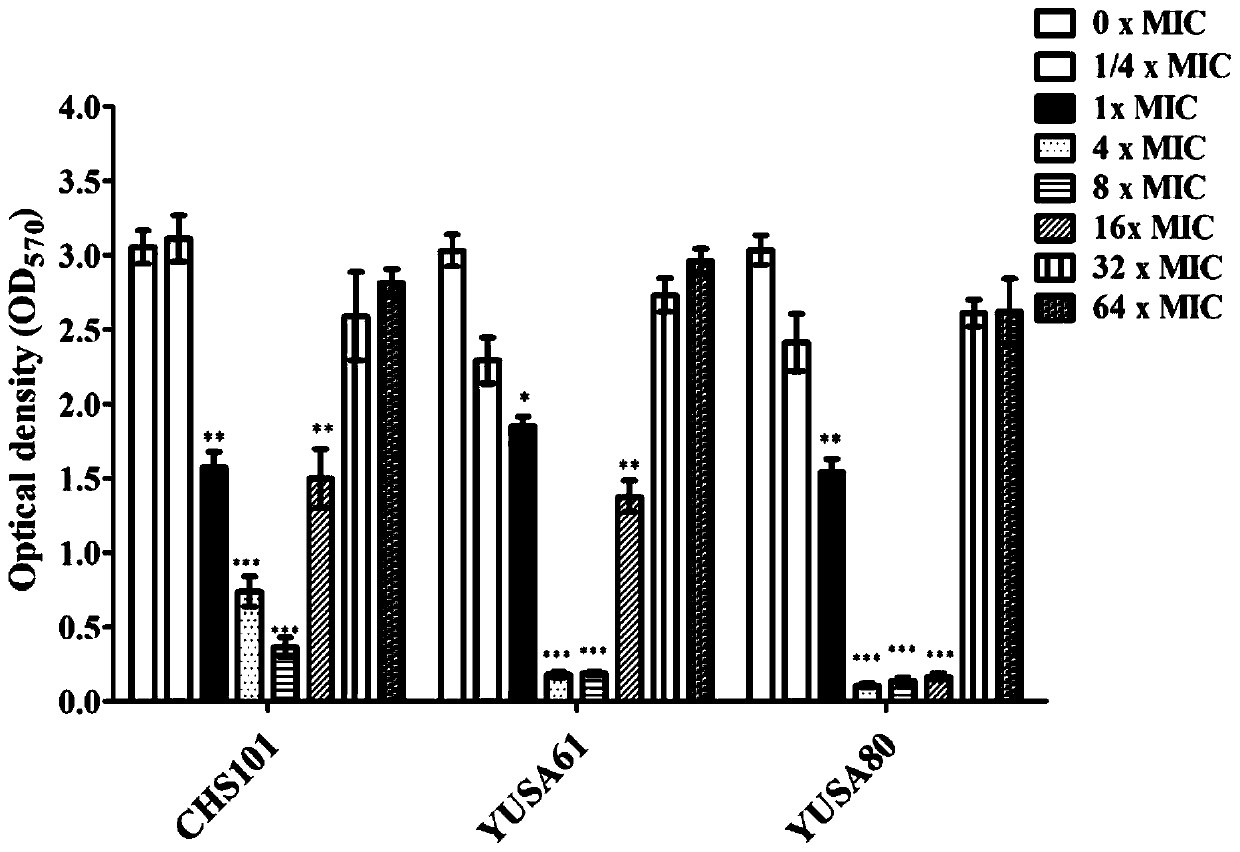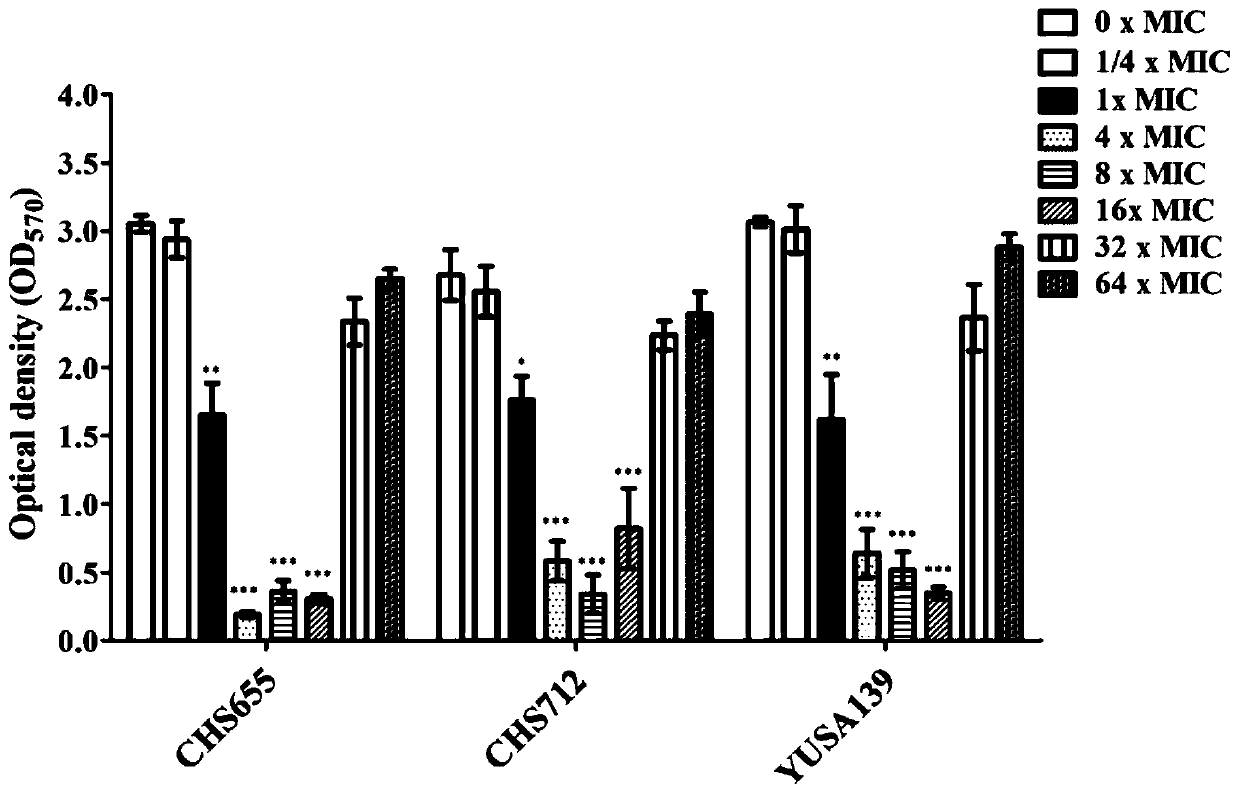Application of bithionol for resisting biofilm infection of staphylococcus aureus
A technology of thiobisdichlorophene and staphylococcus, which is applied in the field of medicine, can solve the problems of poor treatment effect of biofilm infection, and achieve the effect of reducing repeated chronic infections
- Summary
- Abstract
- Description
- Claims
- Application Information
AI Technical Summary
Problems solved by technology
Method used
Image
Examples
Embodiment 1
[0027] Minimum inhibitory concentration (Minimum inhibitory concentration, MIC) detection:
[0028] The minimum inhibitory concentration (MIC) was carried out by the micro broth dilution method, with ATCC29213 as the quality control strain, and the operation was carried out according to the CLSI-M100-S27 version. The results are shown in Table 1 below. The MIC of thiobisdichlorophene to 25 clinically isolated Staphylococcus aureus strains (including methicillin-sensitive strain MSSA and methicillin-resistant strain MRSA) was 2.2 mg / L. Table 1. The minimum inhibitory concentration of thiobisdichlorophene to Staphylococcus aureus
[0029]
Embodiment 2
[0031] Thiobisdichlorophene can effectively remove the biofilm formed by Staphylococcus aureus test:
[0032] Staphylococcus aureus SA113 strain was cultured overnight in TSB medium at 37°C and 220rpm / min for 10-12h. Dilute the bacterial solution 1:200 with TSBG medium (TSB medium + 0.5% glucose), add 200ul per well to a 96-well plate (Costar3599), set 3 duplicate wells for each strain, and culture at 37°C for 24 hours to form a mature organism film. Discard the supernatant, wash with sterile normal saline 3 times (200ul / well / time), then add fresh TSBG medium (containing different concentrations of thiobisdichlorophene / thiochlorophene), and culture it statically for 48h (each After 24 hours, replace with a new medium), discard the supernatant, wash with PBS 3 times (200ul / well / time), dry at room temperature, add methanol to fix for 15min (200ul / well), discard methanol and dry at room temperature Add 100ul of 0.5% crystal violet staining solution to each well, stain at room t...
Embodiment 3
[0035] Sulfur bisdichlorophene / thiochlorophene can kill Staphylococcus aureus in biofilm test:
[0036] The Staphylococcus aureus strain was cultured overnight in TSB medium at 37°C and 220rpm / min for 10-12h. Dilute the bacterial solution 1:200 with TSBG medium (TSB medium + 0.5% glucose), add 2ml per well to a 24-well plate (Costar 3524), set 3 duplicate wells for each strain, and culture at 37°C for 24 hours to form a mature biofilm. Discard the supernatant, wash with sterile normal saline 3 times (200ul / well / time), then add fresh TSBG medium (containing 8x MIC concentration of thiobisdichlorophene or no drug), and culture statically for 48h ( Replace with new medium every 24 h). Discard the supernatant, wash with sterile normal saline for 3 times, then scrape off the biofilm at the bottom of the well with an autoclaved toothpick, resuspend in 1ml of normal saline, add trypsin to fully digest for 30 minutes, and then Wash twice with normal saline, then take 100ul after 1:...
PUM
| Property | Measurement | Unit |
|---|---|---|
| concentration | aaaaa | aaaaa |
Abstract
Description
Claims
Application Information
 Login to View More
Login to View More - R&D
- Intellectual Property
- Life Sciences
- Materials
- Tech Scout
- Unparalleled Data Quality
- Higher Quality Content
- 60% Fewer Hallucinations
Browse by: Latest US Patents, China's latest patents, Technical Efficacy Thesaurus, Application Domain, Technology Topic, Popular Technical Reports.
© 2025 PatSnap. All rights reserved.Legal|Privacy policy|Modern Slavery Act Transparency Statement|Sitemap|About US| Contact US: help@patsnap.com



